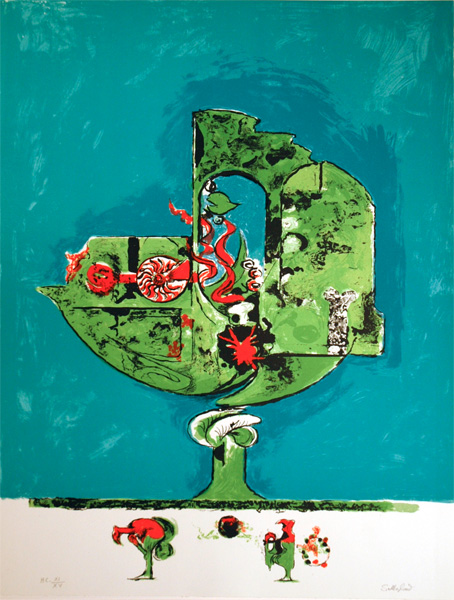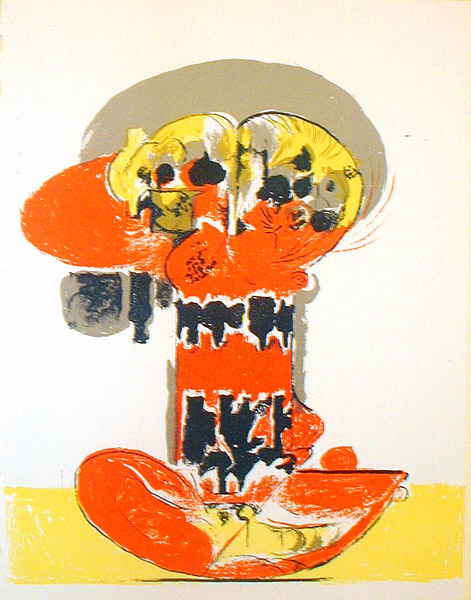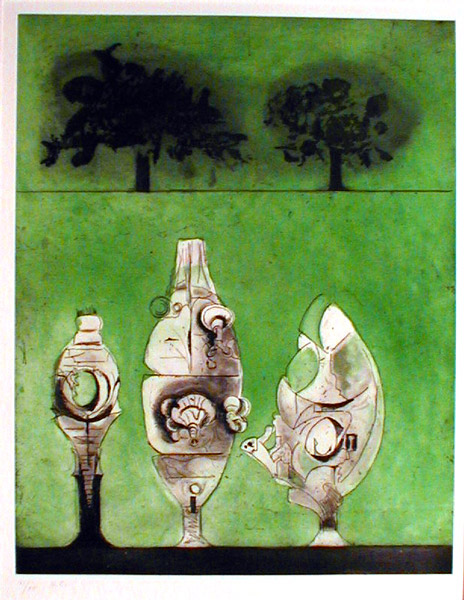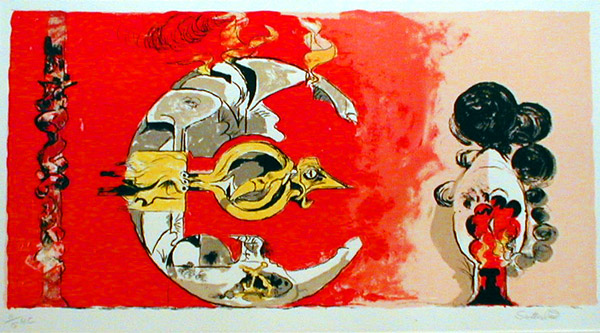|
Sutherland was one of a generation of artists who, influenced by Samuel Palmer, revived the art of etching with a romantic vision of the English landscape. The Pembrokeshire coast became a lifelong source of inspiration and he developed a highly personal response bordering on the abstract. He contributed to the International Surrealist Exhibition in London, and became an Official War Artist. The Christian image of the Cross became a recurring theme and he was commissioned in 1952 to design the Christ in Glory in the Tetramorph for Coventry Cathedral. His portrait of Churchill, to mark the Prime Minister's 80th birthday caused a sensation at its unveiling in 1954, and was subsequently destroyed by the sitter's wife.
After his death, Sutherland's reputation went into eclipse for reasons not at all clear. As the BBC has commented,
In this, the centenary of his birth, there is no major retrospective of his work on show. Yet Sutherland was once a household name in Britain. When an artist was needed to create a massive centrepiece for the new cathedral at Coventry (which was to be a showcase of English modern art) Sutherland was the obvious choice. His reputation eclipsed that of contemporaries such as Francis Bacon
Graham Sutherland worked as an engineering draughtsman at Derby railway works (at his father's insistence), before studying etching at Goldsmiths College of Art. He dedicated himself to print-making during the 1920s, producing romantic landscapes. He later worked with watercolours, and finally, during the 40's, in oil. It is for his surreal, organic oil paintings, inspired by the wild coastline of Pembrokeshire, that Sutherland is best known. He was a member of the 40s neo-Romantic movement, and like the 19th-century Romantics, eulogised a natural British landscape, untouched by the ravages of industrialisation and war. Sutherland had first-hand experience of the latter. From 1940 to 1945, he worked in the War Artists' Scheme, drawing bomb-sites, blast furnaces, tin-mining and quarrying
He was not the kindest of portrait-painters. His portrait of Lord Beaverbrook pictured the newspaper baron as a cunning, reptilian creature. On receiving the present, commissioned by his staff, Beaverbrook said, "It's an outrage, but it's a masterpiece!" Winston Churchill detested Sutherland's portrait of him as a declining old man. Hel said of it at the official unveiling, tongue firmly in cheek, "It is a remarkable piece of modern art - it certainly combines force and candour". Churchill's wife had the painting burnt a year or two later. However, Sutherland's final preparatory sketch was exhibited publicly at the Olympia Fine Art and Antiques Fair in London this February, having been lost for 25 years.
In the late 40's Sutherland started holidaying in France and in 1955, he and his wife, Kathleen, bought a fashionable modernist house near Nice. Having left Britain, his work lost something of its original edge. However, in 1967 he visited Pembrokeshire for the first time in years with an Italian TV company who were making a film about him. His return to the Welsh landscape that inspired him sparked a second flowering of his creative powers.
There are signs that this situation is changing. As the BBC noted, "There are plans to build a major exhibition centre for Sutherland's work in St. David's in Pembrokeshire." As the bibliography below suggests, Since Sutherland's death, his work continues to be shown and a second and complete catalogue raisonné of his prints has been published.
Bibliography: Ronald Alley, ed. Graham Sutherland: Catalogue (London: Tate Gallery 1982); Francesco Arcangeli, Graham Sutherland (NY: Abrams, 1973); Roger Berthoud, Graham Sutherland : A Biography (London: Faber & Faber, 1982); Luigi Carluccio, Graham Sutherland. I Maestri del Colore 120 (Milano: Fratelli Fabbri Editori, 1966); Douglas Cooper, The Work of Graham Sutherland (NY: David McKay Company, 1961); John Hayes, Portraits by Graham Sutherland (London: National Portrait Gallery, 1977); John Hayes, Graham Sutherland (Oxford: Phaidon, 1980); Felix H. Man, Graham Sutherland: Das Graphische Werk, 1922-1970 (München: Verlag Galerie Wolfgang Ketterer, 1970); Edward Sackville-West, Graham Sutherland (Harmondsworth: Penguin Modern Painters, 1943); Stedelijk Museum, Graham Sutherland (Amsterdam: Stedelijk Museum, 1952); Graham Sutherland, An exhibition of paintings and drawings by Graham Sutherland arranged by the Arts Council and the Tate Gallery (London: Arts Council of Great Britain, 1953); Graham Sutherland. Druckgraphik und Zeichnungen mit dem vollständigen Bestiarium (Nürnberg: Albrecht-Dürer-Gesellschaft, 1969); Roberto Tassi, Graham Sutherland: Complete Graphic Work, ed. Edward Quinn (Barcelona: Ediciones Poligrafa, 1988); Hanna Bekker vom Rath, Graham Sutherland: Oelgemälde, Gouaches, Graphiken (Frankfurt: Frankfurter Kunstkabinett, 1957).
|
|
|
|
Spaightwood Galleries, Inc.
To purchase, call us at 1-800-809-3343 (1-508-529-2511 in Upton MA & vicinity) or send an email to spaightwood@gmail.com
We accept AmericanExpress, DiscoverCard, MasterCard, and Visa.
We also accept wire transfers and paypal.
For directions and visiting information, please call. We are, of course, always available over the web and by telephone (see above for contact information). Click the following for links to past shows and artists. For a visual tour of the gallery, please click here. For information about Andy Weiner and Sonja Hansard-Weiner, please click here. For a list of special offers currently available, see Specials.
All works are sold with an unconditional guarantee of authenticity (as described in our website listing).
Copyright 2004-2017, Spaightwood Galleries, Inc.
Go back to the top of this page.
Visiting hours: Saturday 10:00 am to 5:00 pm and Sunday noon to 6:00 pm and other times by arrangement.
Please call to confirm your visit. Browsers and guests are welcome.
|
|
|



